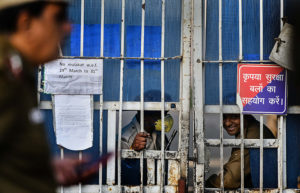When a murderer who was released early due to ‘good behaviour’ raped and tortured a minor girl, it exposed flaws in the rehabilitation programme in our prison system
In the first week of August, a minor girl child was raped and tortured in Delhi’s Peeragarhi area of Paschim Vihar. The accused had reportedly come with the intent to rob her home, but when the 12-year-old resisted, he attacked her viciously.
The accused is a 33-year-old man, Krishna Kumar, who had been found guilty of murder in 2006, and sentenced to life imprisonment, but released early in 2014 from Tihar jail due to “good behaviour”. This makes us think about our prison systems, its reform programmes, and just how many of the men inside will be returned to the outside world with a sense of deadly intent.
In Delhi, recidivism – the tendency of a convicted criminal to re-offend – was seen amongst 9,979 people arrested under IPC, according to the 2018 National Crime Records Bureau data. This was from the total number of arrests, which stood at 99,875.
Out of this number, there were 180 juveniles who were ‘apprehended but not convicted in the past’ and 67 who were under the bracket of ‘apprehended and convicted’ in the past.
For adults, the total number of persons in the first category was 8,172, while those who were convicted in the past were at 1,560, making Delhi’s recidivism rate at 10%.
A source privy to information on prisons says that there are on average at least 25% of prisoners annually who are repeat offenders from Delhi’s Tihar jail. He believes economic factor is the main reason behind re-offence, and also believes many re-commit crimes to come back to prison. “A person who is poor, lives on the streets, commits a crime is put behind bars. They get food every day, don’t have to worry about their clothes, their bed, everything is provided for them including medical facilities. Inside the prison cells, there are prisoners who will get paid by working for a fellow inmate who is wealthy, doing their chores.”
There have been reports that out of the couple of thousands who were released when Covid-19 lockdown was first announced, many have gone back to a life of crime, specifically theft, robbery and snatching. But our source tells us that of the people released during the Corona pandemic, who were attached to the skill development programme, only a few returned to prison, showing that the rehabilitation programme had perhaps helped these individuals.
In the case of the brutal attack on the 12-year-old girl, the man in question had been convicted for murdering a 26-year-old woman after breaking into her house in Sultanpuri. According to the Indian Express, Kumar is a resident of Mangolpuri, a school dropout, who had turned to a life of petty crimes. In 2006, he invaded the woman’s home with an accomplice. When the woman tried to raise an alarm, he killed her.
Observer Research Foundation writes that reducing recidivism involves the education of the inmates, psychotherapy and skilling them for meaningful employment opportunities after the end of their sentence.

Early last year, to keep a check on mental and behavioural disorders among more than 16,000 inmates lodged in the 16 jails of Tihar Prison Complex, the Delhi Prison Administration announced that it had provided counselling to as many as 7,000 inmates.
Dr Syed Umarhathab, Secretary at the Indian Society of Criminology says in the country while certain prisons are empowered with a good system, facilities and officers, in most of them there will be one or the other lacking. “Tihar has all the facilities for reformation and rehabilitation. The one process is to have a good officer in charge and it would definitely have a good impact.”
But despite this, he says one of the main reasons why people get back into the pattern of crime is not being accepted by society. “One of my students has done his PhD in ‘Reintegration of the released prisoners’ and as per his findings, and my views, it is generally the acceptance in the society and social stigma that makes people re-offend.”
According to the labelling theory of Edwin Lemert, he says, once a person is labelled as primary deviant, he may become a secondary deviant also. “So, when we go by this theory, it could be about 20% of the released prisoners who will re-offend because of the social stigma”.
He also points to the constant suggestions of creating halfway homes, a concept far from being achieved; and the need of having good probation officers in place. “To the best of my knowledge, many of them are clerks who have been promoted as probation officers. But only people with two kinds of backgrounds would be relevant for this job. One is a criminologist and those working in the community development field.”
What would help a prisoner to change his life, Umarhathab says is the right kind of vocational training. “Prison systems often give prisoners training which include candle making, or chalk making. But when prisoners are released, they find themselves in want of jobs. The training should be a little more advanced, like in computers, mobile phone repairing, things which will likely help them get more job opportunities.”
Akshita Raina, a lawyer in Delhi, is working to relaunch Preshti, an organisation which will look into providing prisoners with access to mental health treatment and vocational training. Training which includes managerial skills, including for self-employment and also physical training in areas like construction. They hope to start in district jails of Delhi and Uttar Pradesh to provide help to juveniles, women and long-time incarcerated prisoners.
But with Coronavirus, reform has slowed down. Prisoners languish in over-crowded jails, while some are released without the correct assessment of the prisoner.
(Cover: In Delhi, recidivism amongst 9,979 persons arrested under IPC in 2018 was found by the NCRB data // Photo: Getty )





